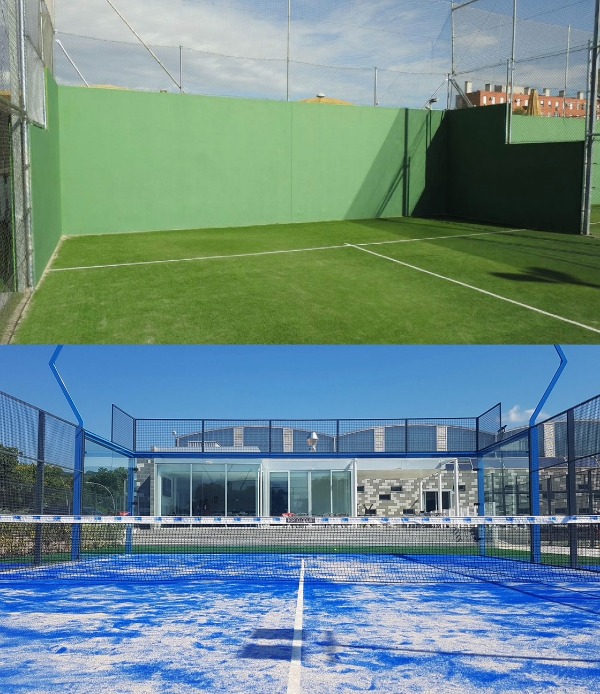Origin of padel
The vast majority Everyone agrees that modern cricket as we know it was born in 1969 in Acapulco, Guerrero.
The origin of the sport, like many other great discoveries throughout history, was entirely accidental.
Enrique Corcuera, considered the founder of the padel movement, had a small garden in his house, but it wasn’t big enough to build a tennis court, which is what he wanted . So, taking advantage of the fact that there are two opposing walls on his property, he puts a net in between. Later he got annoyed at having to pick them up as the balls would run away from him and ended up adding lower walls on the sides so they couldn’t “run away” and the vegetation wouldn’t invade court. After that, Enrique and his friends quickly realized that they could continue playing when the ball bounced off the wall, and in this casual way, padel as we know it today was born.
Padel pitches…wall or glass?
Originally, courts were made of walls. No glass court.
Glass was born in Argentina when the professional circuit started to gain a larger following so spectators could watch games from the outside.
In Spain, until 2000, the vast majority of courts were wall courts. Even on the professional circuit, they haven’t played on wall courts until recently. In fact, Juan Martín Díaz and Fernando Belasteguín against Cristian Gutiérrez on the squash court at the 2007 Padel Pro Tour Lost 1 year and 9 months of unbeaten streak against Seba Nerone.
Also, at this time, it is quite normal to find concrete cricket pitches or “fast” tennis courts. But soon, the playing field was changed to artificial turf.
Wall courts are slower than glass courts because the glass bounces faster.

presence of personal paddle boards
Officially, cricket is a two-player game. However, singletons also exist.
Although 90% or more of cricket grounds are doubles grounds, some clubs or centers also have singles cricket grounds. These pitches, while the same length at 20 metres, are narrower than the official pitches at 6 meters wide instead of 10 metres.
Obviously, they don’t use these courts for official games, but they are good for training or one-on-one matches.
Padel is not yet an Olympic sport
Although cricket is not yet an Olympic sport, calls for it to become one are growing.
Padel is currently played in 57 countries around the world, and to become an Olympic sport, the men’s event must be played in at least 75 countries on four continents and the women’s event must be played in 40 countries on three continents.
Some experts believe that paddle tennis has the potential to become an Olympic sport in the 2032 Games. hope so!
The first cricket bat/racquet was made by..
Originally, all bats were made entirely of wood. This obviously made them stiffer and heavier than they are now, not to mention harder to fight and more prone to injury.
Later, they started to evolve and take players’ needs into consideration. Therefore, in 1989, the Sane brand was the first to use soft materials in rackets. In fact, the name of the brand is an acronym: “sistema antivibratorio de núcleo elástico”, which translates to – elastic core anti-vibration system.
The origin of the word “padel”
The word “pádel” is a Spanish adaptation of the English word “paddle,” which means paddle or racket.
The Spanish Royal Academy (RAE) added the term in the 23rd edition.
It gives us the following definition: “A game of ball between four walls, struck with a racquet”.
oldest player
Gonzalo Cunqueiro is believed to be the oldest virtuoso player of all time.
In 2010, 92-year-old Gonzalo entered the cricket field with a bat in one hand and a cricket bat in the other.
This fact further reinforces the statement that “cricket can be played at any age” and it doesn’t require excellent physical condition.
cricket vs tennis
Although they look the same at first glance, they are not.
A padel ball is 1 mm larger than a tennis ball and weighs 1 gram. But the biggest difference between them is the pressure. A padel ball has less pressure than a tennis ball, so it has less bounce.
out of court
There is no doubt that seeing a player fly off the pitch and come back to even score a point is one of the most spectacular moves we have seen in the sport.
However, this move has only recently occurred. This is because until a few years ago most pitches had side fences that were 4 meters high instead of the 3 meters they are today. Also, there was less space between the courts and the gates of the courts were narrower and not as protected as they are now. Therefore, it becomes more difficult to pass the ball from the sideline and return the ball to the outside.
“Magic” Sans is considered to be the first player to return the ball outside the court. He himself once said that “at that time, returning the ball outside the court was almost a feat.” Interestingly, Alejandro Sanz also invented the “dormilona” shot.
first spanish number one
* Cadiz native Juan LeBlanc is the first Spaniard to reach the world No. 1 ranking. LeBron achieved the milestone after an absolutely epic season in 2019 when he signed with his partner Paquito Navarro. The pair have won five games: Alicante, Jaén, Valladolid, Bastad and Sao Paulo. In the latter, Juan LeBlanc became the first Spanish-born World Padel Tour No. 1 after reaching the final.
first world cricket championship
The first World Padel Championships are held in Spain. It was held at the same time as the 1992 Seville World Expo. It also has a second parallel venue: La Moraleja de Alcobendas Golf Club in Madrid.
Since then, the World Championships have been held in Argentina, France, Portugal, Canada, Mexico and Paraguay, as well as in Parma, Murcia and Madrid.
Learn more about padel: here
Learn from the pros and reach #DIFFERENTLEVEL: here







